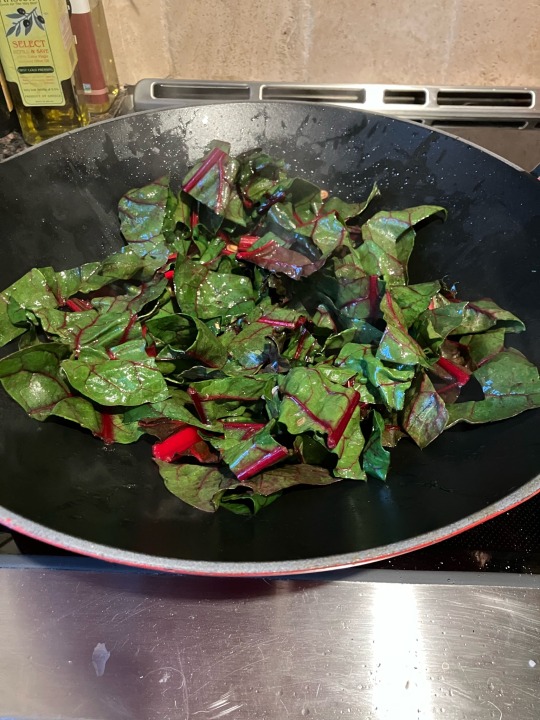#fuchsia dunlop
Explore tagged Tumblr posts
Text
Anyone who insists that Chinese food has to be cheap and junky reveals only their own lack of experience, like a writer of tabloid horoscopes ranting to an astrophysicist about the stars.
—Fuchsia Dunlop, Invitation to a Banquet
#this book is making me so hungry all the time#china#food#fuchsia dunlop#chinese food#chinese cuisine#Chinese culture
18 notes
·
View notes
Text
Recipe off the List: Classic Dan-Dan Noodles from Every Grain of Rice
Ever have that moment when you're planning out the meals for the week and have altered a recipe enough to accommodate food restrictions and realize it's really not the original recipe any more?
Yeah, that's what happened with this one. Classic Dan-Dan Noodles uses ground pork. Well, we didn't have any of that in the house, but we do have a lot of beef in the freezer. So, Partner was going to grind some and I'd use that. But then we realized that was the only night of the week Metamor could come over for dinner. Instead of choosing a different recipe, I just decided to use tofu instead of beef (or pork).
But Metamor is gluten-free. So instead of the usual Chinese wheat noodles, Partner bought GF fettuccine and rice noodles. I used the fettuccine since it was at least the same shape.
The closest I came to actually following the recipe was steaming the CSA greens which happened to be bok choi like in the remains of the oil and things cooked in the wok.
So yeah, this was nothing like Classic Dan-Dan noodles. The spicing was good though.
Recipe: Try Again

#culinary vagabond#foodie#food#foodblr#cooking#cookblr#cookingblr#foodpics#food pics#my crazy recipe list#dinner#lunch#tofu#pork#beef#every grain of rice#fuchsia dunlop
4 notes
·
View notes
Text
Made Fuchsia Dunlop's Mapo Tofu, and I was shocked at how easy it was. Just soak tofu in hot, salted water, slap some ingredients in a wok to make the sauce, then strain the tofu and simmer (and add corn starch, but that barely counts as a step). Tiny amount of chopping required.
Easy, delicious, A+ recipe.
On the other hand, I also made the Chinese Cooking Demystified tofu recipe, and... is it really necessary to cook the soy milk with pulp? Why can't I strain it first? It's the traditional method, sure, but what difference does it make?
The added pulp increases the total volume, so when the soy milk foamed up it overflowed my pot, getting soy grit all over my stove, my counter, my cat... Also, trying to strain the hot milk was a pain. Literally.
No complaints about the end result, though.
2 notes
·
View notes
Text
0 notes
Text
#books#history#nonfiction#food#fuchsia dunlop#hmmmm#skeptical about the merits of this book because it's a white person writing about asian food#but maybe it's not so bad?
1 note
·
View note
Text
Classmates loved my Pockmarked Old Woman Tofu peace and LOVE on planet Earth
#eternally grateful to Fuchsia Dunlop#Chinese cooking demystified and last but CERTAINLY NOT least the beautiful and vast and diverse country of CHINA#mapo tofu btw. that's the translated name
1 note
·
View note
Text
didn't feel equal to the task of food this evening, but then i remembered that dandan noodles have a remarkable ratio of reward to effort. especially if you drink the noodle water. thanks Fuchsia Dunlop
16 notes
·
View notes
Text
Life Update Tag Game
Tagged a while back by the lovely @laindtt <3 Thank you! :D
🎧 Last song: Abracadabra by Lady Gaga
🖍️ Favorite Color: Red (and blue, but if I have to choose one then red)
📚 Last Book: The Food of Sichuan by Fuchsia Dunlop
🎥 Last Movie: Presence (2024)
🍜 Sweet/Spicy/Savory: Hard choice, I’ve been in a spicy & savory mood lately. I’ll say savory for now!
💕 Relationship Status: Single :)
🌐 Last thing I Googled: How to fix a leaky kitchen faucet (The sink decided to break right as guests were over…)
💓 Current Obsession: I’m hopping around a lot right now but I’m currently interested in researching unique chili pepper varieties for this gardening season. I'm also jumping between BG3 and RDR2 haha
🔮 Looking Forward to: I'm looking forward to starting my seeds for this year's garden and the release of Lady Gaga’s new album! :D
Tagging: @harmonyowl @strafethesesinners @teamhawkeye @purplehairsecretlair @adelaidedrubman @roses-n-rads @rosecochonnetduprintemps @glowwormsmith @fuckin-nancy @direwombat @miss-jennifer-cormier @bardic-inspo @mel-eficent and anyone else who wishes to do it! :)
13 notes
·
View notes
Text









Tagged by @alliluyevas to post 9 books I'm planning to read in 2025!
The Day Lasts More than a Hundred Years by Chingiz Aitmatov - this has been on my list forever (it's literally the third book on my TBR shelf on Goodreads) but my library doesn't have it and I've never managed to find a copy at my local indie/used bookstore, but I got it for Christmas this year so I'm excited to finally read it.
Kindred by Octavia Butler - I feel like I've been putting off reading Butler because I know it'll be so good and I want to save it, but at this point it's almost embarrassing I haven't gotten around to anything by her yet.
La Belle Sauvage by Philip Pullman - I didn't even know Pullman has written a new series until recently, but His Dark Materials was easily one of my favorites as a kid.
Prairie Fires: The American Dreams of Laura Ingalls Wilder by Caroline Fraser - I only found out this book existed recently but I was obsessed with the Little House series as a kid, I literally went as a pioneer girl in a little floral dress and apron and bonnet for Halloween one year, Kirsten was my fave AG, etc., so naturally I am interested.
The Vanished Birds by Simon Jimenez - The more I think about A Spear Cuts Through Water, the more I like it in retrospect, and I've seen multiple people whose opinions I trust say they liked this book better.
Doctor Zhivago by Boris Pasternak - I am literally embarrassed to have a degree in Russian literature and somehow have never read this book, but here we are. I actually started it over the holidays but I found the Pevear/Volokhonsky translation to be almost unreadable and that's the only version my library has, so I need to get my hands on the Hayward/Harari translation instead.
Invitation to a Banquet by Fuchsia Dunlop - My partner really loves to cook and Dunlop is probably his favorite chef/food writer, so we're planning to read this together.
Glorious Exploits by Ferdia Lennon - I know basically nothing about this book except that it has one of the more unique historical fiction premises that I've seen in a while.
Café Europe Revisited by Slavenka Drakulić - Another one I've been wanting to read for a while, but since it's Drakulić I knew I'd want a copy for my shelf instead of just getting it from the library, and I finally got it for Christmas.
Tagging @alvallah, @maddie-grove, @alynoakenfists, @leguinning, and anyone else who wants to do it!
5 notes
·
View notes
Text

"In Invitation to a Banquet, award-winning cook and writer Fuchsia Dunlop explores the history, philosophy, and techniques of Chinese culinary culture. In each chapter, she examines a classic dish, from mapo tofu to Dongpo pork, knife-scraped noodles to braised pomelo pith, to reveal a distinctive aspect of Chinese gastronomy, whether it’s the importance of the soybean, the lure of exotic ingredients, or the history of Buddhist vegetarian cuisine."
8 notes
·
View notes
Text
Recipe off the List: Smothered Rainbow Chard with Garlic (Men Cai Hong Cai) from Every Grain of Rice
I am always interested in extending the number of and types of vegetables I (, Partner, and Kiddo) eat. Especially since something random can and will show up in the CSA box at any time. Since I'm still, after twenty years, dependent on recipes, it's good to have something in my back pocket for a wide variety of stuff. Beyond, roast them.
At least, that's my excuse for the shelf of saved recipes in the cookbook bookcase.
Kiddo ate this one: leafy greens are easier to get them to eat, especially when prepared simply. Pretty hard to get simplier than some oil, the water clinging to the leaves from washing the chard, some garlic, and the chard itself.

Stir-frying in a wok is one of those things I've been doing long enough to consider easy. Plus, there's a leave it alone to steam step, which makes it an easy recipe to work in around the other dishes for the meal.
The taste was crisp and bright too, so I (and everyone else) liked it.
Is it the most flavorful or complex dish? No. Sometimes that's what you want: a simple dish highlighting a specific ingredient/taste. That's what I got here.
Recipe: Keep
1/2lb. rainbow chard
2–3 tbsp. oil
3 cloves of garlic, sliced
Wash the chard and shake dry-ish. Trim the ends of the chard. Chop into bite-sized pieces, including the stems.
Heat the oil in a wok over medium-high heat. Add the sliced garlic and stir-fry until fragrant but still white.
Add the chard and stir-fry until beginning to wilt. Cover the wok and allow to steam for 10 minutes, until stems are cooked through.
Serve.

#culinary vagabond#foodie#food#foodblr#cooking#cookblr#cookingblr#foodpics#food pics#my crazy recipe list#side#vegetable side#keep#vegetarian#vegan#fuchsia dunlop
3 notes
·
View notes
Text
Cooking with Cultural Influences: Infusing Dishes with Global Flavors
Cooking with Cultural Influences: Infusing Dishes with Global Flavors
Cooking is a universal language that transcends borders and cultures. When we cook, we not only nourish our bodies but also connect with our heritage, traditions, and community. Cooking with cultural influences is a wonderful way to explore new flavors, techniques, and ingredients, while also paying homage to the rich culinary diversity of our world. In this blog post, we'll embark on a culinary journey to explore the joys of cooking with cultural influences.
The Benefits of Cooking with Cultural Influences
Cooking with cultural influences offers numerous benefits, including:
Cultural exchange and understanding: Cooking with cultural influences allows us to connect with different cultures, traditions, and histories.
Flavor diversity: Exploring global cuisines exposes us to new ingredients, spices, and cooking techniques, which can add depth and excitement to our cooking.
Creativity and inspiration: Cooking with cultural influences encourages creativity and experimentation, as we adapt and modify traditional recipes to suit our tastes and preferences.
Community building: Sharing meals and cooking traditions with others fosters connection, understanding, and community.
Exploring Global Cuisines
Here are some popular global cuisines to explore:
Asian cuisine: Chinese, Japanese, Korean, and Thai cuisines offer a wealth of flavors, ingredients, and cooking techniques to discover.
Mediterranean cuisine: Greek, Italian, Spanish, and Middle Eastern cuisines share a rich tradition of olive oil, herbs, and fresh vegetables.
Latin American cuisine: Mexican, Brazilian, and Peruvian cuisines blend indigenous, African, and European influences, resulting in vibrant, flavorful dishes.
Indian cuisine: With its diverse regions and cultures, Indian cuisine offers a staggering array of spices, ingredients, and cooking techniques to explore.
Cooking Techniques and Ingredients
Here are some essential cooking techniques and ingredients to get you started:
Stir-frying: A fundamental technique in Asian cuisine, stir-frying involves quickly cooking ingredients in a wok or large skillet.
Braising: A cooking method used in many global cuisines, braising involves cooking tougher cuts of meat in liquid over low heat.
Spices and herbs: Familiarize yourself with global spices and herbs, such as soy sauce, miso paste, cumin, coriander, and sumac.
Grains and legumes: Explore global grains like rice, quinoa, and couscous, as well as legumes like lentils, chickpeas, and black beans.
Recipes to Get You Started
Here are some delicious recipes to introduce you to cooking with cultural influences:
Korean bibimbap: A signature Korean rice bowl dish topped with vegetables, meat (usually beef), and a fried egg.
Indian chana masala: A popular North Indian dish made with chickpeas cooked in a rich, spicy tomato-based sauce.
Japanese teriyaki salmon: A classic Japanese dish featuring grilled salmon glazed with a sweet teriyaki sauce.
Moroccan chickpea and spinach stew: A hearty, flavorful stew made with chickpeas, spinach, and aromatic spices.
Conclusion
Cooking with cultural influences is a rewarding and delicious way to explore global flavors, techniques, and ingredients. By embracing the diversity of global cuisines, we can enrich our cooking, broaden our palates, and connect with cultures and communities around the world.
Cooking with Cultural Influences Resources
Cookbooks: "The Essentials of Classic Italian Cooking" by Marcella Hazan, "The Joy of Cooking" by Irma S. Rombauer, and "Land of Plenty" by Fuchsia Dunlop
Food blogs: The Wandering Chopsticks, The Kitchn, and Food52 offer a wealth of global recipes, cooking techniques, and cultural insights
Online cooking classes: Websites like Masterclass, Cookpad, and Udemy offer online cooking classes and courses on global cuisines and cooking techniques
Global food markets: Visit local global food markets or international grocery stores to discover new ingredients, spices, and cooking supplies.
0 notes
Text
that's not true at all??? this is an 'independent' article about this book from august 2020 where the author explains her love of noodles as having come from being taken to dim sum restaurants by her british grandfather as a child. she wasn't raised in an asian family.
"Middlehurst admits she wrote the book with her past self very much in mind. “One of the things I struggled with the most when I started out was just being completely overwhelmed by Asian ingredients,” she says. “If you go to an Asian supermarket, there are seven to 10 different types of soy sauce, and Chinese soy sauces are different to Japanese soy sauces and then knowing which brand to use and what’s the difference between light and dark soy sauce... it’s just totally overwhelming and it’s one of the questions that I get asked the most... ..Middlehurst’s love for Asian cooking started in childhood. Her first interaction with it was when her well-travelled grandfather would take her and her brothers for authentic dim sum. She has fond memories of the “steaming dim sum trolleys”, “bamboo baskets” and “new and unfamiliar flavours and textures”, an experience that was far removed from the typical Asian food available in Britain at the time. “Meat and two veg never really did it for me,” she adds, and this combination of factors inspired her to seek out her own recipes to try... ...She turned to Asian chefs Ken Hom, Ching He Huang and Fuchsia Dunlop for inspiration. “That’s where I learned most of the early knowledge I had, that’s how I found different recipes, that this is called this and that is called that,” she explains. “But I still found it difficult to know which brand of sauce to buy or why am I using that or where do I get that, what aisle is it in in the supermarket, where does it come from in the world, what its flavour profile is, can I use it in these dishes or is just for this one dish?” She wanted to go deeper, so she started searching for blogs written by Asian people for Asian people. “I’m really good now at deciphering Mandarin recipes that have been translated on Google,” she jokes."
i kinda smelled bullshit when no one specified an ethnicity anywhere in the post above in relation to the food she was making or the people she was supposedly raised by.
i feel like this is so indicative of this website and race. we're not crazy for pointing out cultural colonization, particularly when the response from white people to something supposedly innocuous is to go on an instant and intense defensive. the author of this book researched east and southeast asian recipes from asian chefs and compiled them from an outsider perspective. would the book get as much press from figures like nigella lawson or be covered by the independent if it weren't written by a white woman? that's a fair question to ask. not 'does she have the right to write about noodles and dumplings?' but 'why does curated culture sell better with white folks than the lived experiences from those cultures?'
also participating in a culture and selling it are two different things. the latter absolutely implies ownership. learn the difference between participation and consumption, please.

#good on nigella for showing up green in shinagami eyes#which - hey - someday we're gonna have a real talk about the extensive appropriation of japanese culture on the english speaking internet#i hope i live to long enough for people to actually fucking hear me#actually nikkei
36K notes
·
View notes